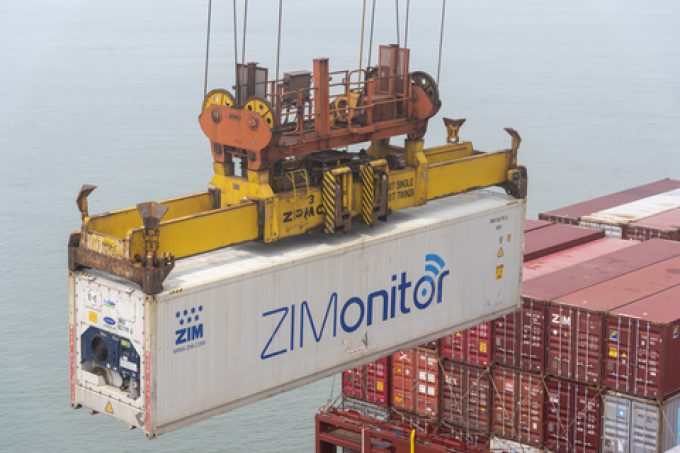US mega-airlines grow cargo volumes, but miss out on ecommerce boom
The three US mega-airlines – Delta, United and American – expanded their cargo traffic in ...
TFII: SOLID AS USUALMAERSK: WEAKENINGF: FALLING OFF A CLIFFAAPL: 'BOTTLENECK IN MAINLAND CHINA'AAPL: CHINA TRENDSDHL: GROWTH CAPEXR: ANOTHER SOLID DELIVERYMFT: HERE COMES THE FALLDSV: LOOK AT SCHENKER PERFORMANCEUPS: A WAVE OF DOWNGRADES DSV: BARGAIN BINKNX: EARNINGS OUTODFL: RISING AND FALLING AND THEN RISING
TFII: SOLID AS USUALMAERSK: WEAKENINGF: FALLING OFF A CLIFFAAPL: 'BOTTLENECK IN MAINLAND CHINA'AAPL: CHINA TRENDSDHL: GROWTH CAPEXR: ANOTHER SOLID DELIVERYMFT: HERE COMES THE FALLDSV: LOOK AT SCHENKER PERFORMANCEUPS: A WAVE OF DOWNGRADES DSV: BARGAIN BINKNX: EARNINGS OUTODFL: RISING AND FALLING AND THEN RISING

Israel’s Zim is pushing an optimistic forecast for the second half of 2023 after worse-than-expected first quarter losses, but analysts remain circumspect over the Israeli carrier’s future.
After bagging net income of $1.7bn in Q1 2022, Zim recorded a net loss of $58m, as a volume decrease of 10% in the same period this year led to revenues collapsing, down 63% to $1.33bn. Amid plunging rates, 64% down year-on-year to $1,390 per teu, this culminated in a $14m loss in ebit.
Chief financial offier Xavier Destriau told The Loadstar: “Looking forward, we think the demand side is presently subdued by the destocking cycle in the US.
“This, though, will at some point come to an end and given that Q3 is the peak season for the transpacific trade on which we operate, we expect the cycle to reset in time for that traditional third-quarter peak.”
Reaffirming its full-year guidance, Zim said it was forecasting ebit of $100m -$500m, in contrast to analyst projections of a loss of $95m.
Broker Jeffries described the move as “surprising”, and one predicated on the hypothetical need for US restocking, rather than any sort of demand rebound – which many are reticent to predict amid what remains an uncertain market.
Such optimism over a rebound at any point this year is in marked contrast to all other carriers, the likes of Hapag-Lloyd, Maersk, and Yang Ming having claimed Q1 will be their strongest.
Perhaps most worrying for Zim is that those carriers recorded profits, if muted, over the period, and while Drewry’s senior manager Simon Heaney would not rule out a possible H2 recovery, he said he thought it unlikely given the foundations for one were not in place.
“There may not be a contradiction between what those carriers are saying and what we are saying as they were on the tailwind of their long-term contracts,” Mr Destriau continued.
“We do not get those tailwinds as we are on transpacific and our contracts are negotiated May to April, so when the spots collapsed in Q3 our customers told us there was such a disconnect between our contract rates and spot that we had to drop them, leaving us spot exposed in Q1.
“Some of our competitors managed to get their customers committing while we had to wait for contract renewals.”
One industry consultant challenged this, telling The Loadstar it was a “nonsense”, noting all carriers on transpacific trades were exposed to the same issue and that Zim’s projections for the remainder of the year were “extremely optimistic” but were in the hands of the market.
Given that Zim charters almost its entire fleet, the consultant said that the carrier was under more pressure than its top-10 competitors, although again Mr Destriau projected confidence.
“Our fleet is mostly chartered but there is a distinction to be made between short and long-term charter and we shifted in late 2020 early 2021 when there was a shortage of capacity towards the latter,” he said.
“We did this by entering the new-building market via an agreement with Seaspan that will see us take hold of long-term charters that also accelerates our greener shipping push.”
Mr Destriau said some of these ships had already come on line, with some 40 more to come, noting that these charters were not exposed to charter rates but new building price, providing critical capacity at a much cheaper rate.
The carrier’s decision to cut its dividend to zero, an analyst told The Loadstar, was indicative of Zim’s own “really cautious” views on what comes next.
Acknowledging this sense of caution, Mr Destriau said: “We are mindful of how things may develop, and [our cut to dividends] is us being cautious as we await the new normal for the industry, but it is not a change to the policy, we’ve maintained our variable dividend policy.
“And it is a policy that over 24 months has seen dividends of $38 per share, which is sizeable, but with no profit there is no dividend.”
Comment on this article